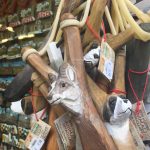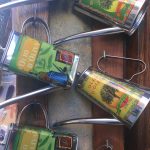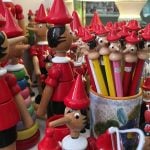There’s nothing like a few days in Italy to turn even a fast-food junkie into a foodie. Italians are proud of their culinary heritage and my tour guide, Enrico Grassi is a goodwill ambassador of all things cultural and gastronomical in the boot-shaped country.
Even scenic pullovers are an opportunity for Enrico to give us a lesson in Italian cuisine.
The Crete Senesi landscape
As we leave Siena en route to Orvieto, our first stop is at a pullover to ooh and ahh at Crete Senesi, a remarkable landscape. The name literally means “Senese clays” and the distinctive color of the landscape comes from the sediments of the Pliocene Sea that covered the area roughly 2.5-4 million years ago.
Enrico stages a group photo there and I think every single one of us took a panoramic shot (like mine here) with our phones.
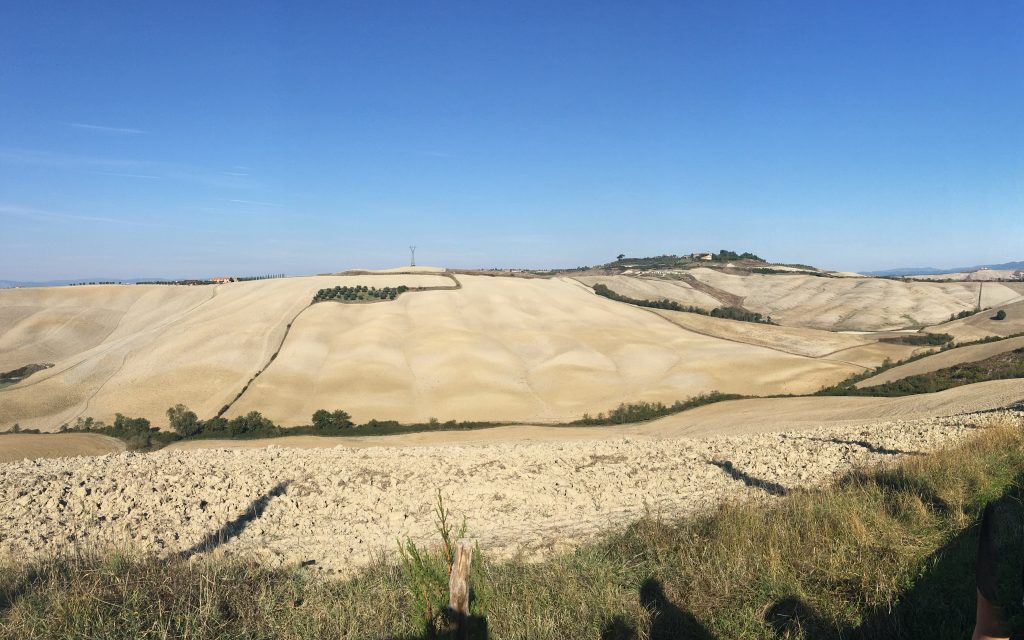
The spectacular Crete Senesi landscape grows lots of tasty foods!
Despite looking other-worldly, the clay soil is ideal for growing the region’s famous crops and livestock. Back home in North Carolina, the only thing our red clay grows is pottery and bricks!
Pecorino cheese, prosciutto ham and Steak Florentine
Enrico explains to us that sheep milk from this region produces pecorino cheese. It owes its unique flavor to the scented bushes and herbs of the Crete region that comprise the sheep’s diet: artemisia, goat’s beard, sweet cicely, musk milfoil, popolino, and bird’s-foot trefoil.
When aged it is hard —like Parmesan. Younger pecorino is soft like a firm brie, with a milder taste. Pecorino cheese in these parts is basically a family product, and folks are rightly proud of it. As Enrico explains in the video above, the Tuscans also play field games with the cheese rounds!
Enrico also told us to watch for another distinctive animal in the region, the Sienese Cinta, a white-belted black pig. Its prosciutto ham is obtained exclusively from animals slaughtered at between 12 and 15 months. After slicing, the ham undergoes salting, then is desalted, left in the refrigerator and peppered, and finally aged on wooden slabs.
I don’t recall seeing any of the pigs, but we did pass a herd of another legendary animal, immortalized in some of ancient Rome’s famous art sculptures—the giant and majestic Etruscan Chianina.
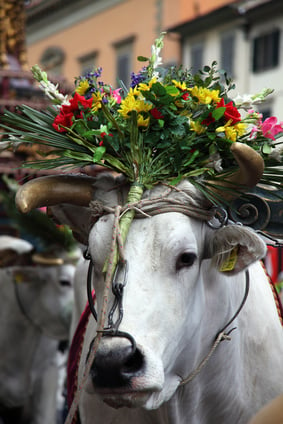
Italy’s majestic Etruscan Chianina spiffed up for a festival
Known as the “white bull of central Italy” we recognized a herd from Enrico’s description as we rounded a curve and they turned their faces to watch us, their white and slightly downturned horns looking as though they were dipped in black paint at the tips.
Steak Florentine comes from these animals. If you order the dish in Italy they won’t even ask how you want it prepared. Because the Italians know best how to serve you, you’ll get it rare and you’ll enjoy it. Period.
A Pienza dance party
As with every other September day on our tour, the weather is spectacular: sunny and in the low 70’s (and as a resident of the American South, I must also add, “with mercifully low humidity”). For lunch, we head to Pienza, considered the “ideal city of the Renaissance.”
Originally called “Corsignano,” the town was transformed by the vision of a hometown boy who later became Pope Pius II. After the city’s rebirth he renamed it “Pienza” which means “pius,” proof that Renaissance popes knew the power of branding.
Entering the city an accordion player and percussionist are singing and playing in the Piazza Martiri della Liberta and am delighted when a dance party breaks out. Two slim bicyclists in their 60’s or 70’s, wearing yellow hi-viz riding gear steal the show with their flamboyant moves while an American woman in dark sunglasses dances and twirls, holding the ten-euro bill she intends to place in the buskers’ suitcase.
They call themselves “Chorobodo” and specialize in Brazilian-Italian peasant songs. Brilliantly so.
Here I am living la dolce vita. No electricity, lights or backstage passes required. Simple living, simple instruments, simple pleasures. See for yourself in the video at the top of this post.
- Hand-carved slingshots
- Olive oil cans into watering cans
- Pinocchio is everywhere in Tuscany!
After doing some souvenir shopping and eating a bite of lunch we saddle up for Umbria by way of Sarteano, a city rich in Etruscan archeology. The Museo Civico Archeologico di Sarteano (Archaeological Museum of Sarteano) is waiting for my next visit, since we are there for a quick potty/coffee/gelato break.
Speaking of gelato, the coffee shop on the piazza doesn’t make its own, as many do, but has some prepackaged gelato treats. I ask Enrico which one he recommends, and after surveying the freezer cabinet, says he can’t recommend any of them in good conscience. Apparently there is “junk food” in Italy after all, and Enrico is my human shield.
I’ll tell you more stories from Italy this year, since I’m returning to ride my motorcycle through Tuscany, Corsica, and Sardinia in 2017. Subscribe in the purple button above and you’ll never miss an installment of the story.
Here is the beginning of the series. The next installment is from Orvieto, rich in Etruscan heritage.
